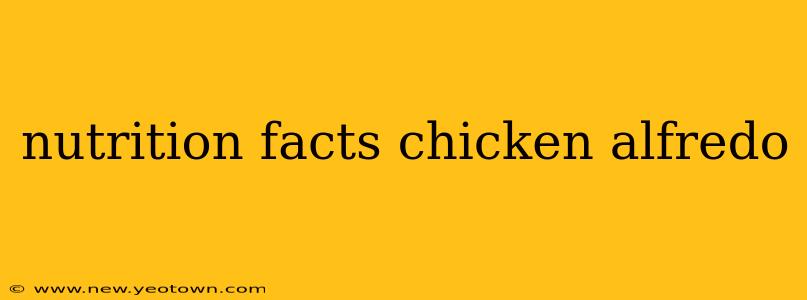Ah, Chicken Alfredo. The creamy, comforting embrace of pasta, succulent chicken, and a rich, cheesy sauce. It's a dish that evokes feelings of warmth and indulgence, but let's face it – we often wonder about the nutritional implications of this beloved classic. This isn't just about calories; it's about understanding the macronutrients, vitamins, and minerals that make up this culinary masterpiece (and how to make it a little healthier). Let's embark on a delicious journey to uncover the nutritional facts behind Chicken Alfredo.
How Many Calories are in Chicken Alfredo?
This is the burning question, isn't it? The calorie count of Chicken Alfredo varies dramatically based on several factors: portion size, type of pasta, amount of sauce, type of cheese used (Parmesan vs. cream cheese), and even the type of chicken (breaded vs. unbreaded). A typical restaurant serving can easily clock in at 700-1200 calories, a substantial portion of your daily intake. Homemade versions can be lighter, depending on the ingredients, but still, a generous serving can be around 600-800 calories. It's all about mindful portion control and ingredient choices.
What are the Macronutrients in Chicken Alfredo?
Beyond calories, we need to consider the macronutrients: carbohydrates, fats, and proteins. The primary source of carbs comes from the pasta, contributing significantly to the calorie count. Fats are predominantly from the creamy Alfredo sauce, rich in butter, cream, and cheese. The chicken provides a good source of protein, offering essential amino acids. The precise macronutrient breakdown will depend on the recipe, but generally, expect a higher percentage of carbohydrates and fats compared to protein.
Is Chicken Alfredo High in Fat?
Yes, Chicken Alfredo is undeniably high in fat. The creamy sauce is the culprit, with butter, heavy cream, and cheese contributing to a significant saturated fat content. Saturated fat, when consumed in excess, can negatively impact cholesterol levels, increasing the risk of heart disease. Moderation is key, and exploring healthier alternatives (like using reduced-fat cream or incorporating vegetables) can help mitigate this concern.
Is Chicken Alfredo High in Sodium?
Many Chicken Alfredo recipes are surprisingly high in sodium, often due to the cheese, pre-made sauces, and added salt. High sodium intake is linked to high blood pressure and other health problems. Opting for lower-sodium cheese and homemade sauces can significantly reduce the sodium content. Reading food labels carefully and choosing low-sodium options is crucial.
What are the Healthier Alternatives to Chicken Alfredo?
You don't have to banish Chicken Alfredo from your life entirely! There are healthier ways to enjoy this favorite dish. Using whole-wheat pasta reduces the glycemic index, while adding plenty of vegetables (like broccoli, spinach, or mushrooms) increases the nutritional value and boosts the fiber content. Substituting some of the heavy cream with Greek yogurt or using a lighter cheese can reduce the fat and calorie count without drastically affecting the taste.
Can I Make a Healthy Chicken Alfredo?
Absolutely! With a few mindful swaps, you can create a more nutritious version of Chicken Alfredo. Opt for whole-wheat pasta, reduce the amount of cream, incorporate plenty of vegetables, use lean chicken breast, and choose lower-sodium cheese. Experimenting with herbs and spices can also enhance the flavor profile without relying on excessive salt or fat. Consider using a lighter sauce, perhaps based on Greek yogurt or a cashew cream.
In conclusion, Chicken Alfredo, while undeniably delicious, should be enjoyed in moderation. Understanding the nutritional composition and making conscious ingredient choices can help transform this decadent dish into a more balanced and healthier meal. Remember, mindful eating is about enjoying your favorite foods without sacrificing your well-being.

